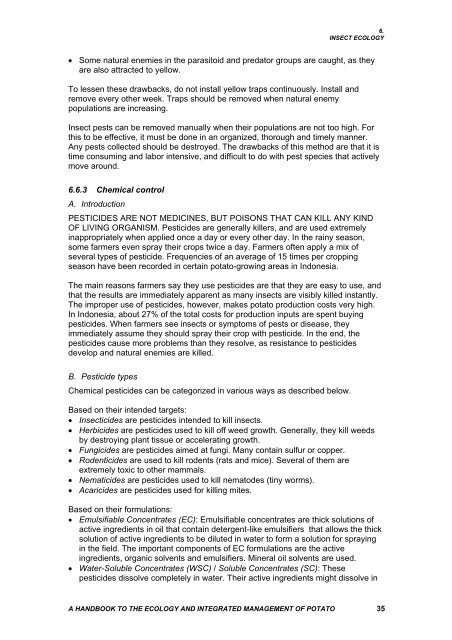All about potatoes.pdf - Vegetableipmasia.org
All about potatoes.pdf - Vegetableipmasia.org
All about potatoes.pdf - Vegetableipmasia.org
You also want an ePaper? Increase the reach of your titles
YUMPU automatically turns print PDFs into web optimized ePapers that Google loves.
6.<br />
INSECT ECOLOGY<br />
• Some natural enemies in the parasitoid and predator groups are caught, as they<br />
are also attracted to yellow.<br />
To lessen these drawbacks, do not install yellow traps continuously. Install and<br />
remove every other week. Traps should be removed when natural enemy<br />
populations are increasing.<br />
Insect pests can be removed manually when their populations are not too high. For<br />
this to be effective, it must be done in an <strong>org</strong>anized, thorough and timely manner.<br />
Any pests collected should be destroyed. The drawbacks of this method are that it is<br />
time consuming and labor intensive, and difficult to do with pest species that actively<br />
move around.<br />
6.6.3 Chemical control<br />
A. Introduction<br />
PESTICIDES ARE NOT MEDICINES, BUT POISONS THAT CAN KILL ANY KIND<br />
OF LIVING ORGANISM. Pesticides are generally killers, and are used extremely<br />
inappropriately when applied once a day or every other day. In the rainy season,<br />
some farmers even spray their crops twice a day. Farmers often apply a mix of<br />
several types of pesticide. Frequencies of an average of 15 times per cropping<br />
season have been recorded in certain potato-growing areas in Indonesia.<br />
The main reasons farmers say they use pesticides are that they are easy to use, and<br />
that the results are immediately apparent as many insects are visibly killed instantly.<br />
The improper use of pesticides, however, makes potato production costs very high.<br />
In Indonesia, <strong>about</strong> 27% of the total costs for production inputs are spent buying<br />
pesticides. When farmers see insects or symptoms of pests or disease, they<br />
immediately assume they should spray their crop with pesticide. In the end, the<br />
pesticides cause more problems than they resolve, as resistance to pesticides<br />
develop and natural enemies are killed.<br />
B. Pesticide types<br />
Chemical pesticides can be categorized in various ways as described below.<br />
Based on their intended targets:<br />
• Insecticides are pesticides intended to kill insects.<br />
• Herbicides are pesticides used to kill off weed growth. Generally, they kill weeds<br />
by destroying plant tissue or accelerating growth.<br />
• Fungicides are pesticides aimed at fungi. Many contain sulfur or copper.<br />
• Rodenticides are used to kill rodents (rats and mice). Several of them are<br />
extremely toxic to other mammals.<br />
• Nematicides are pesticides used to kill nematodes (tiny worms).<br />
• Acaricides are pesticides used for killing mites.<br />
Based on their formulations:<br />
• Emulsifiable Concentrates (EC): Emulsifiable concentrates are thick solutions of<br />
active ingredients in oil that contain detergent-like emulsifiers that allows the thick<br />
solution of active ingredients to be diluted in water to form a solution for spraying<br />
in the field. The important components of EC formulations are the active<br />
ingredients, <strong>org</strong>anic solvents and emulsifiers. Mineral oil solvents are used.<br />
• Water-Soluble Concentrates (WSC) / Soluble Concentrates (SC): These<br />
pesticides dissolve completely in water. Their active ingredients might dissolve in<br />
A HANDBOOK TO THE ECOLOGY AND INTEGRATED MANAGEMENT OF POTATO 35




![Section 4 [ PDF file, 252 KB] - The Field Alliance](https://img.yumpu.com/51387260/1/158x260/section-4-pdf-file-252-kb-the-field-alliance.jpg?quality=85)












